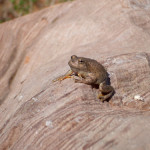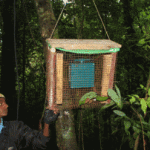The chytrid fungus most likely began in African Clawed frogs, which carry the fungus that causes chytrid, but don’t die from it. In the 1940s these frogs were raised in captivity for pregnancy tests. Most of the frogs were released once this method was no longer used for the tests. They infected amphibians in the United States and around the world.
So far scientists have not found a way to combat this deadly disease that spreads quickly in amphibian populations. Individual animals can be treated, but not large populations of amphibians.
But in this recent study, frogs inoculated with a solution containing the symbiotic skin bacteria survived. The scientists plan to introduce the bacteria to the wild with with a method called bioaugmentation. They hope to increase naturally occurring bacteria so that it can spread to even more frogs and other amphibians.
This summer the scientists will be conducting tests in isolated areas to ensure that bioaugmentation will be safe and environmentally friendly. If successful, this might offer the first real hope for warding off the mass exinction of the earth’s amphibians. Good news indeed for our froggy friends!






Pingback: Fighting to Save Colorado’s Boreal Toad « Frogs Are Green- A blog to raise awareness about the threats frogs face in the world's changing environment...